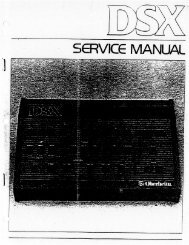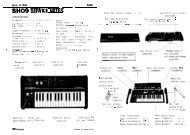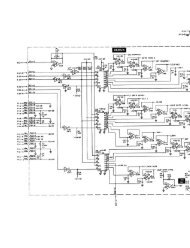ARP2600 - Fundamentals of Music Technology - Cyborgstudio.com
ARP2600 - Fundamentals of Music Technology - Cyborgstudio.com
ARP2600 - Fundamentals of Music Technology - Cyborgstudio.com
You also want an ePaper? Increase the reach of your titles
YUMPU automatically turns print PDFs into web optimized ePapers that Google loves.
SECTION ELEVEN: PREAMP, ENVELOPE FOLLOWER, RING MODULATOR - 085a person speaks more loudly into the microphone, the more control voltage exits the envelope follower.It is important to remember that the envelope follower is not able to sense changes in frequency, andthus, changes in pitch will have no effect on the signal it puts out. It will only detect and react to thevolume <strong>of</strong> the in<strong>com</strong>ing signal. The envelope follower can be used in place <strong>of</strong> an EG whenever anexternal signal is available for use. The envelope follower can thus be used to modulate the VCO’s,VCF, or VCA in a fashion very similar to the way the EG’s modulate them. CD track 60THE RING MODULATORThe ring modulator is the most <strong>com</strong>plex <strong>of</strong> the three modules presented inthis section. Many modern synthesizers claim to have a ring modulator whenthey actually have a balanced modulator. The difference between the two isactually in the design and construction <strong>of</strong> the circuit. This point is beyond thescope <strong>of</strong> this book, but it is important to understand that they are really twodifferent modules. Many synthesizers today have modules which produce ringmodulator-like effects and claim to have ring modulators, when the truth isthat these modules are not ring modulators at all. Synthesizer <strong>com</strong>panies realizethat musicians will be more <strong>com</strong>fortable working with something whichis familiar, and thus continue to use the term “ring modulator.”The ARP 2600’s manual gives a succinct, but mostly useless definition <strong>of</strong> theway the ring modulator works: “The ring modulator is essentially a voltagemultiplier; from two inputs A and B it produces the output function A x B/5.”The ring modulator is much easier to understand when the kind <strong>of</strong> modulationit allows is understood. The ring modulator allows a new kind <strong>of</strong> modulationwhich has not been experienced up to this point. Amplitude Modulation orAM is a process in which the amplitude <strong>of</strong> one waveform is used to modulatethe amplitude <strong>of</strong> a second waveform.HOW DOES THE RING MODULATOR WORK?Essentially, many new harmonics are added to a sound, and the original soundis then removed from the signal using cancellation. To ac<strong>com</strong>plish this, twodifferent signals are input to the ring modulator’s inputs which can be seen inFigure 11-8: The ringmodulatorFigure 11-8. Each in<strong>com</strong>ing waveform has its own frequency content. (Frequency content is defined asall <strong>of</strong> the harmonics <strong>of</strong> a particular waveform. This is also sometimes referred to as harmonic content.)The ring modulator adds the entire harmonic content <strong>of</strong> the two waveforms, and subtracts the harmoniccontent <strong>of</strong> the two waves. The ring modulator <strong>com</strong>es up with a sum and a difference <strong>of</strong> these twoin<strong>com</strong>ing waves. For instance, a 210 Hz fundamental would be added to a 441 Hz fundamental to givea 651 Hz fundamental. Similarly, an 255 Hz fundamental could be subtracted from an 880 Hz harmonicto give a 625 Hz harmonic. The ring modulator causes every harmonic <strong>of</strong> one in<strong>com</strong>ing waveform(including the fundamental) to be added to every harmonic (including the fundamental) <strong>of</strong> the secondin<strong>com</strong>ing waveform and every harmonic <strong>of</strong> one in<strong>com</strong>ing waveform to be subtracted from every harmonic<strong>of</strong> the second in<strong>com</strong>ing waveform. The results are difficult to predict.















